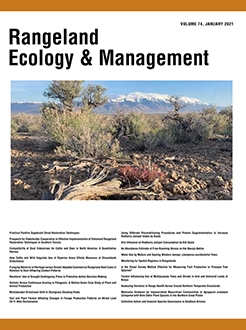We compared animal and vegetation responses of a 13 600-ha area under holistic grazing management (HGM) with a similar area under continuous grazing (CGM) in a Patagonian station. Limitations were a dry 2012–2016 experimental period, poorer soils, and grazing of native guanacos (Lama guanicoe) in the HGM area. Forage standing crop in this area before the experience was lower and remained so during the study: (194 ± 31 HGM vs. 244±33 kg dry matter.ha–1 CGM). Six monitoring sites showed similar and remarkable (though mostly nonsignificant) vegetation improvements in total cover (10.6% HGM vs. 10.9% CGM) and cover of short palatable grasses (21.4% vs. 23.9%, respectively). Species richness showed small changes (–1 vs. –6%), bare soil interpatches decreased (–11.9 vs. –5.4%), and land function indicators of Stability (5.4% vs. 9.9%), Infiltration (12.4% vs. 12.0%), and Nutrient recycling (4.2% vs. 20.6%) increased. Tussock cover changed significantly with grazing management, as it decreased –6% (ns) in HGM and grew 42% (P = 0.03) under CGM, probably due to coarse tussock forage consumption in HGM. Sheep under HGM were 15% lighter (43.9 ± 0.5 HGM vs. 51.7 ± 0.5 kg.ewe–1 CGM P < 0.001), ewes scored 28% lower body condition (1.60 vs. 2.25, P < 0.001), and lambing rates were 36% lower (48.3 ± 2.1% vs. 74.2 ± 1.9%). Rotation ended in 2015 as a consequence of low lambing rates, and sheep body condition and reproductive rates recovered to similar values in both areas. Positive vegetation changes in both areas may be driven by residual effects of destocking 3 decades ago and show that improvement is possible using moderate stocking rates. Although it could be argued that rest periods of HGM may be positive in the long term, its negative effects on animal production should be addressed, and fast regeneration using intense management in these severely restricted habitats should not be expected. Slow, persistent progress under careful management seems achievable under both grazing systems.
How to translate text using browser tools
4 January 2021
Holistic Versus Continuous Grazing in Patagonia: A Station-Scale Case Study of Plant and Animal Production
Gabriel Oliva,
Daniela Ferrante,
Carla Cepeda,
Gervasio Humano,
Silvina Puig
ACCESS THE FULL ARTICLE
biodiversity
grassland management
grazing systems
livestock
rangelands
rotational grazing
Semiarid lands





